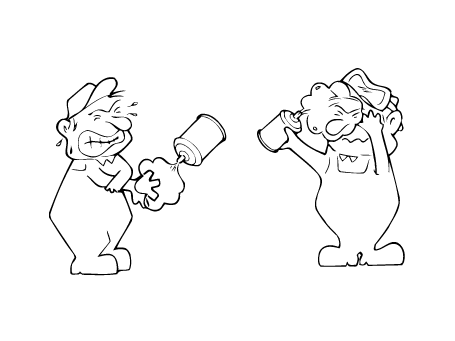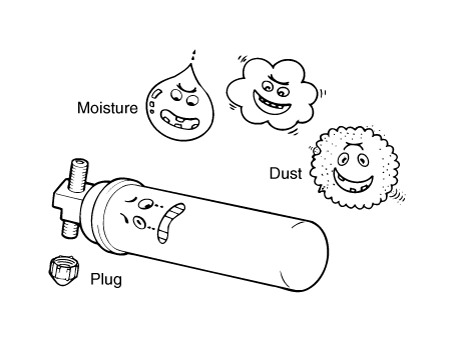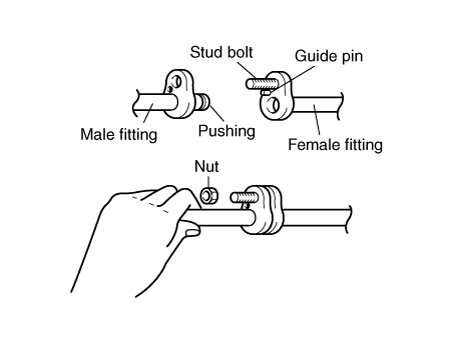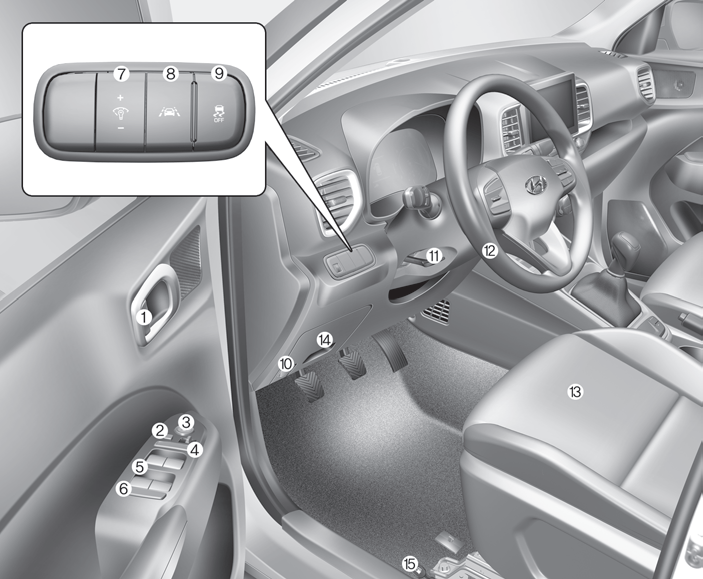Hyundai Venue: Air Conditioning System / General safety information and caution
When Handling Refrigerant
| 1. |
R-134a liquid refrigerant is highly volatile. A drop on the skin of
your hand could result in localized frostbite. When handling the refrigerant,
be sure to wear gloves.
|
| 2. |
It is standard practice to wear goggles or glasses to protect your eyes,
and gloves to protect your hands. If refrigerant splashes into your
eyes, wash them with clean water immediately.
|
| 3. |
The R-134a container is highly pressurized. Never leave it in a hot
place, and check if storage temperature is below 52°C (126°F)
|
| 4. |
An electronic leak detector should be used to check the system for refrigerant
leakage. Bear in mind that the R-134a, upon coming into contact with
flame, produces phosgene, a highly toxic gas.
|
| 5. |
Use only recommended lubricant for R-134a systems. If lubricants other
than the recommended one used, system failure may occur.
|
| 6. |
PAG lubricant absorbs moisture from the atmosphere at a rapid rate,
therefore the following precautions must be observed:
| – |
When removing refrigerant components from a vehicle, cap the
components immediately to prevent entry of moisture.
|
| – |
When installing refrigerant components to a vehicle, do not
remove the cap until just before connecting the components.
|
| – |
Complete the connection of all refrigerant tubes and hoses without
delay to prevent the A/C system from taking on moisture.
|
| – |
Use the recommended lubricant from a sealed container only.
|
|
| 7. |
If an accidental discharge in the system occurs, ventilate the work
area before resume of service.

|
When Replacing Parts on A/C System
| 1. |
Never open or loosen a connection before discharging the system.
|
| 2. |
Seal the open fittings of components with a cap or plug immediately
to prevent intrusion of moisture or dust.
|
| 3. |
Do not remove the sealing caps from a replacement component until it
is ready to be installed.
|
| 4. |
Before connecting an open fitting, always install a new sealing ring.
Coat the fitting and seal with refrigerant oil before making the connection.

|
When Installing Connecting Parts
Flange With Guide Pin
Check the new O-ring for damage (use only the specified) and lubricate by using
compressor oil. Tighten the nut to the specified torque.

Handling Tubing and Fittings
The internal parts of the refrigeration system will remain in a state of chemical
stability as long as pure moisture-free refrigerant and refrigerant oil are
used. Abnormal amounts of dirt, moisture or air can upset the chemical stability
and cause problems or serious damage.
The Following Precautions Must Be Observed
| 1. |
When it is necessary to open the refrigeration system, have everything
you will need to service the system ready so the system will not be
left open any longer than necessary.
|
| 2. |
Cap or plug all lines and fittings as soon as they are opened to prevent
entrance of dirt and moisture.
|
| 3. |
All lines and components in parts stock should be capped or sealed until
they are ready to be used.
|
| 4. |
Never attempt to rebind formed lines to fit. Use the correct line for
the installation you are servicing.
|
| 5. |
All tools, including refrigerant dispensing manifold, gauge set manifold
and test hoses, should be kept clean and dry.
|
| • |
The R-1234yf liquid refrigerant is a flammable gas. The gas
reduces oxygen available for breathing and causes asphyxiation
in high concentrations. The victim will not realize that he/she
is suffocating.
|
| • |
Inhalation may cause central nervous system effects and may
cause drowsiness and dizziness.
|
| • |
Ingestion may cause gastrointestinal discomfort. It may cause
skin irritation, eye irritation and respiratory tract irritation.
Do not breathe vapour. Avoid contact with skin, eyes and clothing.
|
|
|
In case of emergency, the following precautions must be observed; First
aider needs to protect himself. Take off all contaminated clothing immediately.
| – |
Inhalation : Move to fresh air. If not breathing, give artificial
respiration. If breathing is difficult, give oxygen. Use oxygen
as required, provided a qualified operator is present. Call
a physician.
|
| – |
Skin contact : After contact with skin, wash immediately with
plenty of water. Rapid evaporation of the liquid may cause frostbite.
If there is evidence of frostbite, bathe (do not rub) with lukewarm
(not hot) water. If water is not available, cover with a clean,
soft cloth or similar covering. Call a physician. Wash contaminated
clothing before re-use.
|
| – |
Eye contact : Rinse immediately with plenty of water, also under
the eyelids, for at least 15 minutes. In case of frostbite water
should be lukewarm, not hot. Call a physician.
|
| – |
Ingestion : Unlikely route of exposure. As this product is a
gas, refer to the inhalation section. Do not induce vomiting
without medical advice. If conscious, drink plenty of water.
Never give anything by mouth to an unconscious person. Call
a physician immediately.
|
|
|
When handling refrigerant, the following precautions must be observed
:
| – |
Wear personal protective equipment.
|
| – |
Avoid contact with skin, eyes and clothing.
|
| – |
Ensure that eyewash stations and safety showers are close to
the workstation location.
|
| – |
Use only in well-ventilated areas.
|
| – |
Protect from sunlight and do not expose to temperatures exceeding
52°C (125°F).
|
| – |
Follow all standard safety precautions for handling and use
of compressed gas cylinders.
|
| – |
Use authorized cylinders only.
|
| – |
Protect cylinders from physical damage.
|
| – |
Do not puncture or drop cylinders, expose them to open flame
or excessive heat.
|
| – |
Do not remove screw cap until immediately ready for use.
|
| – |
Always replace cap after use.
|
| – |
Container is hazardous when empty.
|
| – |
Prevent the creation of flammable or explosive concentrations
of vapour in air and avoid vapour concentration higher than
the occupational exposure limits.
|
| – |
Keep product and empty container away from heat and sources
of ignition.
|
| – |
Do not pressurize, cut, weld, braze, solder, drill, grind or
expose containers to heat or sources of ignition.
|
| – |
Take measures to prevent the build up of electrostatic charge.
|
| – |
Electrical equipment should be protected to the appropriate
standard.
|
| – |
Use explosion-proof equipment.
|
| – |
No sparking tools should be used.
|
|
| – |
When storing the refrigerant, the following precautions must
be observed :
|
| – |
Pressurized container. Protect from sunlight and do not expose
to temperatures exceeding 52°C (125°F). Do not pierce or burn,
even after use.
|
| – |
Keep containers tightly closed in a dry, cool and well-ventilated
place.
|
| – |
Keep away from heat and sources of ignition.
|
| – |
Storage rooms must be properly ventilated.
|
| – |
Ensure adequate ventilation, especially in confined areas.
|
| – |
Protect cylinders from physical damage.
|
| – |
Store away from incompatible substances.
|
| – |
Store in original container.
|
|
| • |
Un-controlled release of R-1234yf refrigerant in the work area
may result in high concentrations of R-1234yf that can be flammable.
Servicing of R-1234yf systems shall only be done in well ventilated
work areas.
|
| • |
When servicing, maintaining or repairing A/C systems using flammable
refrigerants (mildly flammable or higher) the work place shall
meet all applicable national, regional or local regulations
for work place safety as related to high pressure or flammable
gases.
|
|
| • |
Avoid breathing any refrigerant vapor and lubricant mist. To
remove refrigerant from a A/C system, use service equipment
designed for recovery and removal that is certified to meet
the requirements of the appropriate SAE Standards.
|
| • |
Do not increase pressure, in any R-134a, or R-1234yf mobile
A/C system with shop air or another refrigerant such as HCFC-22
(R-22) for leak checking, due to potential chemical reactions,
flammability of air/R-134a at elevated pressure, contamination
of the system, and possible structural damage to the system.
|
| • |
To prevent an accumulation of refrigerant in case of a major
refrigerant leak, open vehicle windows and doors when charging
an A/C system
|
| • |
To prevent accidental release of refrigerant and minimize safety
concerns, the installation of any refrigerant service equipment
to the vehicle shall only be done with the engine off and after
the refrigerant high side pressure has been reduced (approximately
2 to 3 min).
|
|
| • |
The proper handling procedures should be followed for all refrigerants
as designated by the refrigerant manufacturer’s Material Safety
Data Sheet (MSDS).
|
| • |
Service personnel shall be aware of the high pressure relief
valve location when servicing the vehicle. Service personnel
shall not be under the vehicle when charging the refrigerant
system due to potential sudden release of the high pressure
relief valve.
|
|
When Handling Refrigerant
| • |
Some of the practices, techniques and procedures, as well as
the information, tools and equipment which have been commonly
used in mobile air conditioning system diagnosis and service
of R-12 and R-134a are different for A/C systems using R-1234yf.
Modifications and adjustments have to be made based on the individual
characteristics of each refrigerant. No technician may perform
service or repair on a mobile air conditioning system using
R-1234yf without being trained for the refrigerant being handled.
Under the SAE Standard J2845 the refrigerant system should only
be serviced by trained and certified technicians to insure proper
and safe operation.
|
| • |
Service technicians should always wear proper personal protective
equipment while handling/servicing systems that contain any
refrigerant.
|
| • |
Service technicians shall read and follow the appropriate Material
Safety Data Sheets (MSDS), which provide information on safety
and the proper personal protective equipment to use.
- All contact with liquid or gaseous refrigerant shall be avoided.
- Goggles with side protection and gloves (insulated against
heat loss and impermeable to refrigerant) shall be worn while
working with the refrigerant circuit.
- Exposure of the skin to refrigerant may result in frostbite,
in which case rub affected area with lukewarm water. A physician
shall be consulted immediately regarding the affected skin areas.
|
| • |
A physician shall be consulted immediately in the event of complaints
following exposure to high refrigerant concentrations. Complaint
symptoms may include: increased breathing rate, breathlessness,
headache, accelerated pulse, dizziness.
|
| • |
Avoid breathing A/C refrigerant and lubricant vapor or mist.
To remove refrigerant from the A/C system, use service equipment
designed for recovery of that refrigerant which is certified
to meet the requirements of the appropriate SAE Standards.
|
|
| 1. |
R-1234yf liquid refrigerant is highly volatile. A drop on the skin of
your hand could result in localized frostbite. When handling the refrigerant,
be sure to wear gloves.
|
| 2. |
It is standard practice to wear goggles or glasses to protect your eyes,
and gloves to protect your hands. If the refrigerant splashes into your
eyes, wash them with clean water immediately.
|
| 3. |
The R-1234yf container is highly pressurized. Never leave it in a hot
place, and check storage temperature is below 52°C (125°F).
|
| 4. |
An electronic leak detector should be used to check the system for refrigerant
leakage. Bear in mind that the R-1234yf, upon coming into contact with
flame, produces phosgene, a highly toxic gas.
|
| 5. |
Use only recommended lubricant for R-1234yf systems. If lubricants other
than the recommended one used, system failure may occur.
|
| 6. |
PAG lubricant absorbs moisture from the atmosphere at a rapid rate,
therefore the following precautions must be observed :
| • |
When removing refrigerant components from a vehicle, cap the
components immediately to prevent entry of moisture.
|
| • |
When installing refrigerant components to a vehicle, do not
remove the cap until just before connecting the components.
|
| • |
Complete the connection of all refrigerant tubes and hoses without
delay to prevent the A/C system from taking on moisture.
|
| • |
Use the recommended lubricant from a sealed container only.
|
|
| 7. |
If an accidental discharge in the system occurs, ventilate the work
area before resume of service.
|
| 8. |
Clean all dirt, grease and debris from and around connection joints
before servicing and disassembly of refrigerant connections.
|
Other information:
Replacement
1.
Remove the front seat assembly.
(Refer to Front Seat - "Front Seat Assembly")
2.
Separate the front seat belt buckle wiring (A).
3.
Loosen the mounting bolt and remove the front seat belt buckle (B)...
General Troubleshooting
Information
Before Troubleshooting
1.
Check applicable fuses in the appropriate fuse/relay box.
2.
Using the battery checker (MCR-570 KIT), check the battery for damage,
state of charge, and clean and tight connections...
Categories

1. Door lock/unlock button
2. Outside rearview mirror control switch
3. Central door lock switch
4. Power window switches
5. Power window lock switch
read more














